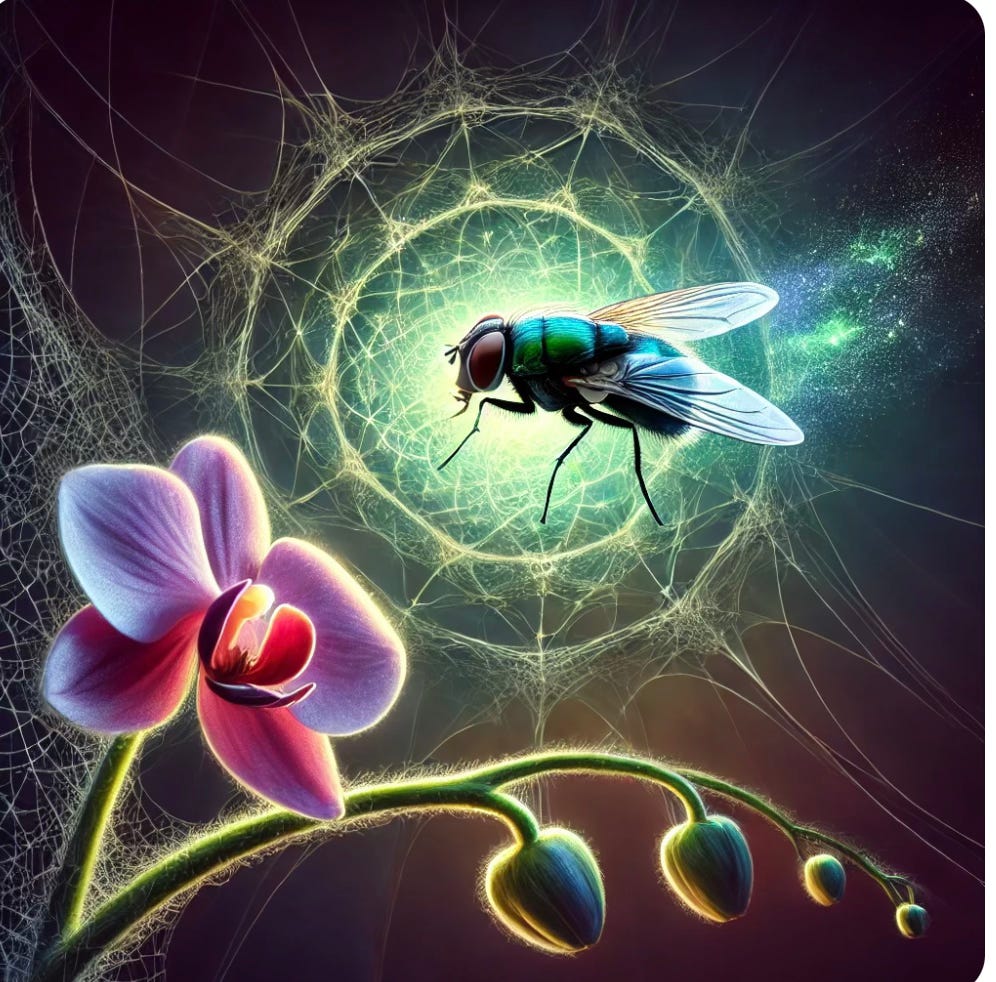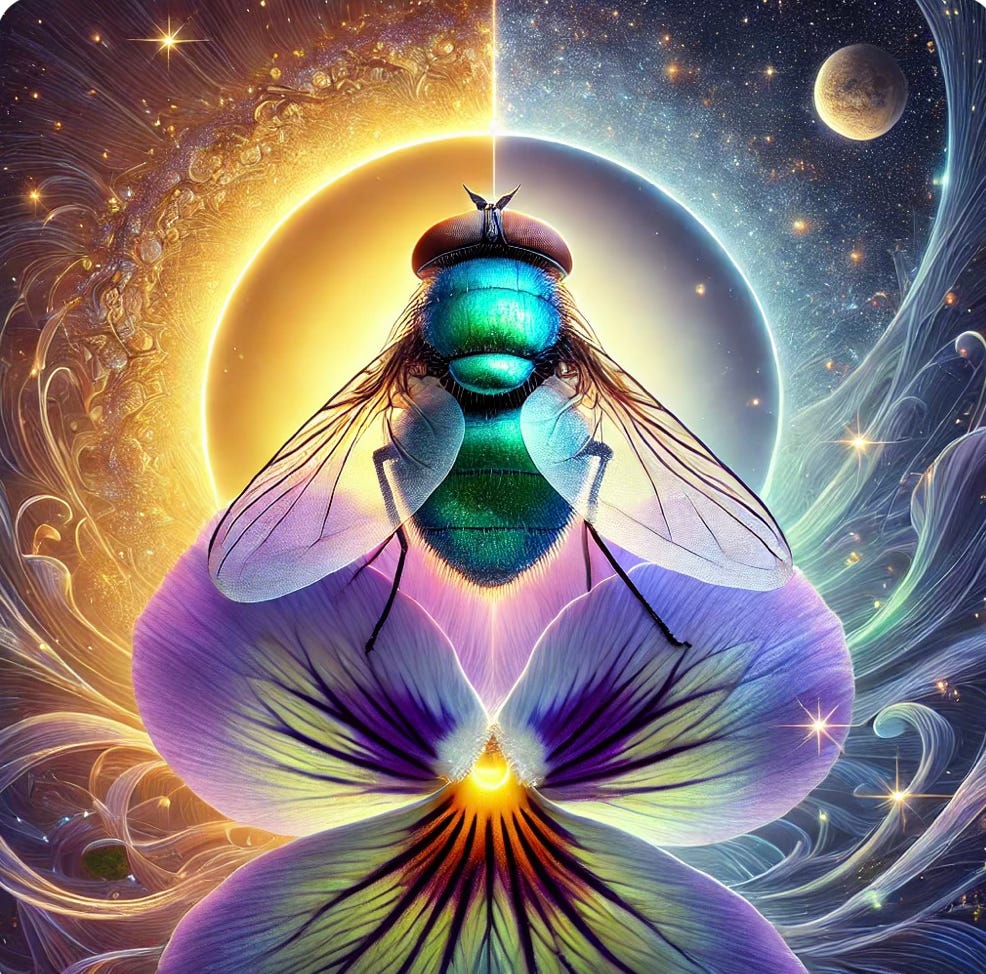Super Fly: A Mind-Blowing Journey into Another Dimension of Life
How These Miniature Marvels Mirror Us and Shape Our World
As i listened on Audible to the author, Jonathan Balcombe, read his book, “Super Fly: The Unexpected Lives of the World’s Most Successful Insects” i felt as though I was stepping into a space-time capsule and being transported to another world, another dimension, another realm of consciousness. With the author as my guide, I explored the magical, otherwise unimaginable complexity of these little beings. I’ve always been fascinated by flies and insects - the speed at which they move, especially to avoid harm, is itself a wonder; their big, see-all eyes; their iridescent, almost hypnotic wings.
Long ago, I stopped eating carcasses, drinking milk meant for baby cows, and consuming eggs meant to become baby chicks. But one summer, about 30 years ago, I became particularly sensitive to flies. I love keeping my windows open and with that came many uninvited winged guests. I found an old fly swatter and was about to swing some fatal blows when I suddenly recoiled at the thought of this human-made killing apparatus taking the life of a being so clearly striving to avoid such a fate. I gave the swatter away and instead tried hanging flypaper, thinking it was a more humane way of killing. But is there ever such a thing? Watching the trapped flies struggle, their fate sealed in sticky glue, I realized this was no better.
Screens weren’t included with my apartment, but I finally realized they could be purchased and easily installed. That simple fix solved the problem and I never again killed another fly. As a child in summer camp, I learned I could simply flick away mosquitos (in the same family as flies) and never killed another after that. The same goes for all insects. I keep my space relatively clean and odor-free, but if I find one in my home, I trap them gently in a see-through container, slide a piece of white cardboard underneath and usher them out a quickly opened and closed window. i pride myself in being able to do this with flies as well. Their vision is almost 360º but where the “almost” comes in is from behind. Twice i’ve trapped one with this knowledge.
If, before reading Balcombe’s “Super Fly,” I hadn’t been sensitized enough to these complex creatures, I certainly am now. The author takes the reader through a journey of discovery, masterfully weaving together personal experiences, fascinating statistics and fanciful facts. His interactions with these creatures and the people who study them add depth and insight.
Midway through, however, I found myself overwhelmed by the density of information, taxonomies and research findings - the intricate threads that weave together this wondrous tapestry. One really needs to focus intently and occasionally my wandering mind lost track. Thankfully, Audible’s 30-second rewind button allowed me to reorient. Part of my challenge was my desire to retain details to share with others - to give them a taste of the book, encourage them to pick it up themselves, and, failing that, at least offer a glimpse of how these creatures exemplify the sacredness and unity of all life. In many ways, they mimic mammals and other vertebrates in their feelings and interactions with the world, playing vital roles in the gestalt.
I felt as though i were journeying through an underground cavern, surrounded by a kaleidoscopic array of shimmering minerals and dazzling gems. At every turn, new wonders emerged - each discovery sparking awe and admiration. Yet, at a certain point, my eyes grew weary from the darkness of the tunnel and the glare of the diamonds and rubies. I felt the need to resurface, return to the familiar landscapes of my everyday world.
For a fleeting moment - shorter than a thought unworthy of prolonged contemplation - I considered putting the book down in favor of fiction or an analysis of the explosive class dynamics in today’s political sphere. Nonetheless, I did press on. When Jonathan Balcombe’s “What a Fish Knows: The Inner Lives of Our Underwater Cousins” was first released, I knew immediately I wanted to read it. The desire only grew stronger when a friend later gifted it to me as a thank-you. Astounded and impressed by “What a Fish Knows,” I decided on a whim to continue my exploration of Balcombe’s studies of the lives of previously overlooked creatures - this time, an insect: the fly.
I’m so glad I didn’t allow my midway fact overwhelm to stop me. The book gets better and better and even built to a crescendo, culminating in revelations beyond their intricate sex lives and reproductive feats. It reaches breathtaking heights as it unveils their unexpected benefits to humans - such as their role in forensic science, determining time of death within hours and their remarkable ability to accelerate wound healing, outperforming modern medicine.
The final chapter struck a deep chord, offering a profound perspective on humanity’s survival as we teeter on the brink of the sixth mass extinction. Perhaps, in the end, flies and other tiny creatures will be among the last survivors. But if we are to persist and stop way before that fateful edge, it will be through cultivating the sensitivity and wisdom that books like this so beautifully provide.






